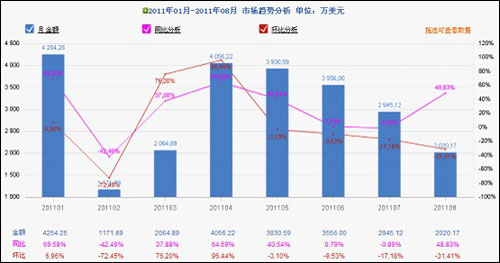U.S. Senate Passes Foreign Exchange Reform Bill to Textile Foreign Trade Enterprise or Faces a New Round of Combat Challenges
2019-02-24 01:06:47
 According to reports, on October 11, 2011, the U.S. Senate passed the "Currency and Exchange Rate Supervision Reform Act of 2011" with a vote of 63 in favor and 35 against.
According to reports, on October 11, 2011, the U.S. Senate passed the "Currency and Exchange Rate Supervision Reform Act of 2011" with a vote of 63 in favor and 35 against. The main content of the bill is to require the U.S. government to impose punitive tariffs on the so-called "undervalued exchange rate" of its major trading partners. It is widely believed that this move is mainly aimed at China and aims to force the police to accelerate its appreciation. The bill, after being approved by the Senate, needs to be passed in the House of Representatives and signed by President Obama before it can become law.
This bill is directed at the exchange rate issue and forces the renminbi to appreciate without hesitation. If the bill is approved, it will undoubtedly subject China's export companies to further exchange rate pressures. Last year, the United States adopted a special case of tires on China caused damage to the Chinese tire industry.
In the post-financial crisis era, the United States wants to use the "heavy burden" of the exchange rate to "correct" the trend of Sino-U.S. trade relations and reverse the US trade deficit with China. According to surveys conducted by Shanghai Teyi through various export industries, if the cost and price of other factors of production are constant, the value of *** will increase by 1 percentage point, and corporate profits will be reduced by 1%. According to different industries, technologically patented companies have better anti-compressive capabilities in this regard, while relatively labor-intensive industries have weaker resistance to *** appreciation.
The textile industry has always been a basic industry for China’s exports. As a typical labor-intensive industry, the textile industry plays a decisive role in the development of China’s foreign trade, but in 2011, with the continued weakness of the international market, textiles The industry has suffered unprecedented blows, and even higher prices have continued to increase against the U.S. dollar, making the company's costs continue to increase. According to the latest statistical data of Speciale Information, from January to August, China exported 190 million meters of knitted fabrics to the United States with an export value of 240 million U.S. dollars. Exports of 40.56 million U.S. dollars in April this year, and exports to 20.2 million U.S. dollars in August, have been in a downward trend since April. Although the average export price has increased year-on-year, the growth rate has slowed down significantly, with the month-on-month decrease of 3.15% in July. (As shown below)
January-August 2011 China's export trend of knitted fabrics to the United States (provided by TOEASE)
According to analysis conducted by the Teiyi Research Institute, although the export of knitted fabrics in China from January to August 2011 was US$240 million, once the bill is approved, it may pose a new challenge to the domestic knitted fabric export enterprises. At present, the domestic knitted fabrics export profit is less than 10%, and some orders profit is the tax rebate rate. If the exchange rate appreciates greatly, coupled with many cost pressures such as raw materials, manpower, etc., if foreign trade companies do not adjust in time there will be a greater risk of survival.
Special-Ease analysts believe that the textile industry exports not only rely on its own price, but also should find the advantages of its own products, build brand value; in the marketing channel, it is even more necessary to take the initiative to understand the market trend, find the market position, many aspects to To open up trade so that we can grasp the initiative of trade, and at the same time put our products and brands out of the country and change the existing embarrassment. Internal repairs and refinements are more suitable for companies to go further than blind sales.
Wall Fan,Electrical Wall Fan,Metal Wall Fan
Stand Fan Industrial Fan Co., Ltd. , http://www.nsfans.com